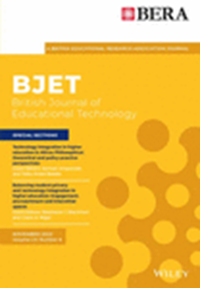Investigating the relationship between math literacy and linguistic synchrony in online mathematical discussions through large-scale data analytics
Abstract
Previous literature has associated math literacy with linguistic factors such as verbal ability and phonological skills. However, few studies have investigated linguistic synchrony, shown in mathematical discussions. This study modelled math literacy and examined the relationship of math literacy with linguistic synchrony between students and facilitators. We retrieved data from 20,776 online mathematical discussion threads at a secondary school level. First, we assessed students' math literacy based on their discussions and classified them into high- and low-math literacy groups. Then, we conducted Cross-Recurrence Quantification Analysis (CRQA) to calculate linguistic synchrony within each thread. The result implies that students with high math literacy are more likely to share common words (eg, mathematical terms) with facilitators. At the same time, they would paraphrase the facilitators' words rather than blindly mimic them as the exact sentences or phrases. On the other hand, students with low math literacy tend to use overlapping words with facilitators less frequently and are more likely to repeat the exact same phrases from the facilitators. The findings provide an empirical data analysis and insights into mathematical discussions and linguistic synchrony. In addition, this paper implies the directions to improve online mathematical discussions and foster math literacy.
Practitioner notes
What is already known about this topic
- Mathematical discussions are known to be an effective way to promote math literacy.
- Math literacy and linguistic skills have a strong link.
- Linguistic synchrony is related to better collaboration and common knowledge building.
What this paper adds
- Reveals the relationship between math literacy and linguistic synchrony and deepens the understanding of digital communication in online learning environments.
- Provides empirical analysis of natural language data in group discussions using CRQA.
- Conceptualizes linguistic synchrony with three sub-concepts: linguistic concurrence, predictability, and complexity.
Implications for practice and/or policy
- Educators and practitioners could utilize the automatic formative assessment of math literacy based on the student's language use in mathematical discussions.
- Educational technology researchers and designers could include CRQA indices and recurrence plots in the dashboard design to provide information to support teachers and learners.
- Teachers would be able to provide real-time interventions to promote effective mathematical communication and foster math literacy throughout mathematical discussions.

 求助内容:
求助内容: 应助结果提醒方式:
应助结果提醒方式:


